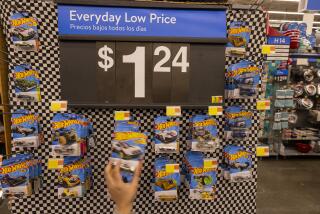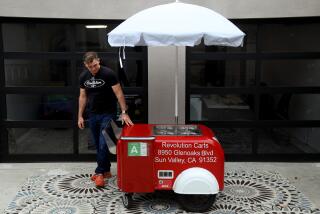Coming Soon to a Grocery Store Near You? : Consumers: Shopping carts equipped with video screens have made their debut. The screens flash store specials, commercials and trivia quizzes.
- Share via
CHICAGO — Video is coming to your supermarket.
Shoppers in suburbs of Chicago, Atlanta and Los Angeles already are pushing carts equipped with 6-by-8-inch screens showing store specials, price cuts, product information, ads and entertainment.
In the 60,000-square-foot Dominick’s supermarket at the Fox Run Square mall in suburban Naperville, for example, you can choose regular, plain-chrome shopping carts or one of 125 video-equipped carts.
Take the VideoCart, being tested by Information Resources Inc. of Chicago, and you get on-screen horoscopes, community news, sports, weather, movie reviews and trivia tests in the checkout line.
“Within 10 years, these carts will be the standard. They’ll be in almost every store in America,” said Bill Dupres, director of operations for the in-store marketing division of Information Resources.
As customers wander through the store, the silent, blue-tinted screen mounted on the cart’s handle flashes weekly specials and price cuts for the department and aisle they’re in, along with brief ads for national and store brands in that aisle.
“I think its neat,” said shopper Renee Kostel. “I normally look for the bonus buys, but this brings them right to my attention.”
Her husband Gary, pushing another cart containing the couple’s two small children, noted the feature that store managers like most.
“It’s great, but we’re buying more than I intended. We really didn’t need this spaghetti, but it was on sale. I saw it on the screen.”
Sales at a Kroger supermarket at the Sprayberry Square mall in the Atlanta suburb of Marietta jumped $20,000 to $30,000 in the first two weeks the carts were tested, according to the industry publication “Supermarket News.”
A spokeswoman for the Vons supermarket in Hermosa Beach said the carts were extremely popular with shoppers there. Customers can touch buttons to find recipes, ingredients needed for those recipes and where to find them, nutrition information and a product locater.
Another button produces a map of the store and a look at exactly where the customer is standing. The cart knows where it is and what information to show by sensing infrared signals from triggers on the ceiling.
“It’s also fun,” said Kostel.
Push the cart past the produce-department sensor and the liquid-crystal-display screen shows that leaf lettuce is down from $1.49 to 98 cents a pound. Turn down aisle three, the cookie aisle, and an ad for cookies pops up.
As customers approach the checkout lines, they can play on-screen trivia games (“Are Oscars coated with 18- or 24-karat gold?” Answer: 24).
They can read capsule movie and video reviews, a seven-day weather forecast or community-news items from local schools and organizations.
Shoppers in Chicago and Los Angeles suburbs--but not Atlanta--can see their horoscope.
“We started World War III there because we had horoscopes,” Dupres said.
“They thought the devil was involved. There were complaints; letters, calls to the manager. We pulled it off in Atlanta and expanded community news.”
At the Naperville store, information is transmitted to the carts by radio from a computer in a storeroom at the front of the supermarket. That computer gets its programming weekly over telephone lines from Information Resource offices in downtown Chicago.
Elderly shoppers often take the standard, non-video carts, but other customers, especially younger customers, seem to love the new ones, said Dominick employee Tracy Smrha in Naperville.
Smrha, 23, was greeting shoppers and explaining the carts at the supermarket entrance recently. About 80% of the people who come in choose the video version, she said.
Walter Spencer, a 69-year-old shopper with bifocals, was among those who took up her offer, but he said he would use a regular cart next time.
“I read the newspapers in the morning and I read the ads,” he said. “This has some potential, but it needs work. It’s too difficult to read and should be adjustable for your height.”
Information Resources hopes to have VideoCarts in 1,500 stores within a year and in 5,000 stores by the mid-’90s, Dupres said.
Programming eventually will be sent to local stores via satellite from Chicago, Dupres said.
“Right now, if I want to talk to 5,000 stores, it takes 5,000 telephone calls. With a satellite link, one call would do it.”
The blue-and-white screen will probably be replaced by a color version. The screen already has a speaker installed and there may be a discreet beep to tell shoppers that new information is on-screen.
“It’s the best point-of-purchase advertising medium anybody’s ever come up with, said IRI spokesman Bob Bregenzer. “The products advertised on it are just jumping off the shelves in test.”
VideoCarts are not for sale. The market-research firm of Information Resources sells advertising time, doesn’t charge the supermarket and gives it a cut of the ad revenue and free on-screen advertising time.
“It’s advertiser supported,” Bregenzer said. “When we sell time on it to Nabisco or Ocean Spray, the retailer pays nothing and the shopper doesn’t see an increase in cost.”
More to Read
Eat your way across L.A.
Get our weekly Tasting Notes newsletter for reviews, news and more.
You may occasionally receive promotional content from the Los Angeles Times.










